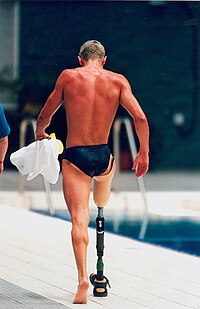
Photo from wikipedia
BackgroundProsthetic hands impose a high cognitive burden on the user that often results in fatigue, frustration and prosthesis rejection. However, efforts to directly measure this burden are sparse and little… Click to show full abstract
BackgroundProsthetic hands impose a high cognitive burden on the user that often results in fatigue, frustration and prosthesis rejection. However, efforts to directly measure this burden are sparse and little is known about the mechanisms behind it. There is also a lack of evidence-based training interventions designed to improve prosthesis hand control and reduce the mental effort required to use them. In two experiments, we provide the first direct evaluation of this cognitive burden using measurements of EEG and eye-tracking (Experiment 1), and then explore how a novel visuomotor intervention (gaze training; GT) might alleviate it (Experiment 2).MethodsIn Experiment 1, able-bodied participants (n = 20) lifted and moved a jar, first using their anatomical hand and then using a myoelectric prosthetic hand simulator. In experiment 2, a GT group (n = 12) and a movement training (MT) group (n = 12) trained with the prosthetic hand simulator over three one hour sessions in a picking up coins task, before returning for retention, delayed retention and transfer tests. The GT group received instruction regarding how to use their eyes effectively, while the MT group received movement-related instruction typical in rehabilitation.ResultsExperiment 1 revealed that when using the prosthetic hand, participants performed worse, exhibited spatial and temporal disruptions to visual attention, and exhibited a global decrease in EEG alpha power (8-12 Hz), suggesting increased cognitive effort. Experiment 2 showed that GT was the more effective method for expediting prosthesis learning, optimising visual attention, and lowering conscious control – as indexed by reduced T7-Fz connectivity. Whilst the MT group improved performance, they did not reduce hand-focused visual attention and showed increased conscious movement control. The superior benefits of GT transferred to a more complex tea-making task.ConclusionsThese experiments quantify the visual and cortical mechanisms relating to the cognitive burden experienced during prosthetic hand control. They also evidence the efficacy of a GT intervention that alleviated this burden and promoted better learning and transfer, compared to typical rehabilitation instructions. These findings have theoretical and practical implications for prosthesis rehabilitation, the development of emerging prosthesis technologies and for the general understanding of human-tool interactions.
Journal Title: Journal of NeuroEngineering and Rehabilitation
Year Published: 2019
Link to full text (if available)
Share on Social Media: Sign Up to like & get
recommendations!